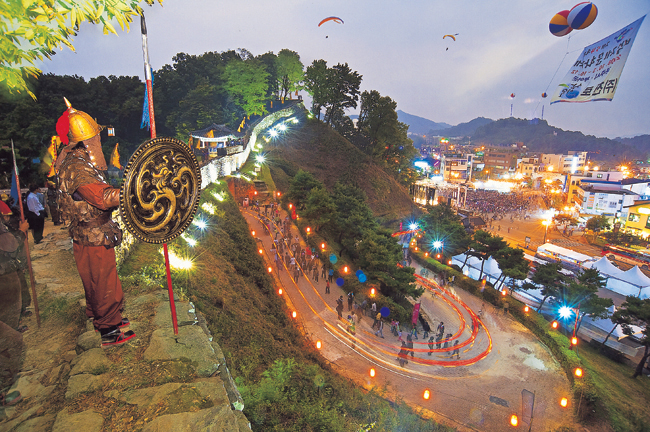
▲ Gongsanseong
Where do you think Baekje built a new kingdom when they moved the capital from Hanseong (now called Seoul) to Woongjin (now called Gongju)? Historians believe that Gonsanseong was the kingdom’s main fortress. Walking along the fortress with a beautiful view, you can feel the affluence and dignity experienced by the Baekje people 1500 years ago.
Gongsanseong: Baekje’s Most Representative and Historic Fortress
Arriving at Gongju, the first thing which visitors encounter is Gongsanseong. King Munju of Baekje moved the capital to Gongju in the first year of his reign (475).
Gongju had been a kingdom until King Sung moved the capital to Bueyo in the 16th year of his reign (538). The Gongsanseong fortress sits at 110m above sea level and is approximately 2.7km long.
The fortress was originally made of mud, but was rebuilt with stones during the Chosun Dynasty. Walking toward Jinamru, some traces of the mud fortress remain visible.
The fortress had a several names: Ungjinseong in Baekje, Gongjusanseong in Goryeo, and Ssangsuseong in the Chosun dynasty. It was built to protect Baekje’s capital, Gongju, and it was the center of local administration in the Chosun dynasty.
The excavations in 1985-86 uncovered many relics, including Baekje roof tiles, lotus-patterned roof tiles, and some pieces of earthenware, which implies that this area is very historically valuable.
On September 23rd, 2014, a wooden storage shed named Mokgwakgo (木槨庫) containing numerous intact relics was excavated and became a hot issue among scholars and laypeople alike.
Relaxing and Peaceful Walking by Geum River
Gongsanseong has four gates facing the North, East, South and West which are known as Youngdongru, Geumseoru, Jinnamru, and Gongbukru. Inside of the fortress exists Ssansujeong, Youngeunsa, Yeonji, Imnyugakji, and Manharuji.
The original Geumseoru, the West Gate was destroyed but was rebuilt in 1993. Standing at Geumseoru, you will be hard-pressed to decide which route to take. If you want to look down the Geum River first, you can head northwest.
The pavilion on the northwest mountain ridge, Gongsanjeong, is an observatory and its name was selected by a public contest. You can enjoy a scenic, panoramic view of the old town and the new town of Gongju along with the Geum River and Geumgangcheolgyo (an iron bridge).
The Geumgangcheolgyo, which was destroyed in the Korean War, was rebuilt in 1952. It is the most historically valuable bridge among numerous ones built over Geum River.
Starting from Gongsanjeong, if you go around Gonbukru, you will reach at Manharu. In front of the Manharu, there is Yeonji, presumed to have been used used from the Baekje period to Chosun period, and is perhaps the most picturesque part of the whole fortress.
Walking on the Fortress, Feeling Baekje’s Breath
Climbing a steep slope, you will take a deep breath and find yourself in awe of Imnyugak. According to the Chronicles of the Three States (三國史記), it was built during King Dongseong’s reign (500) and used for a banquet venue.
It is the most palatial pavilion out of the existing structures in Gongsanseong. If you climb a little more, you run into Gwangbokru,which is located on the top of the Gongsanseong.
This pavilion was originally called Wungshimgak, but the independence fighters, Gu Kim and Siyoung Lee, visited the place to pray for independence and changed its name to Gwangbokru, meaning “independence pavilion.”
The east gate of Gongsanseong, Youngdongru was excavated and restored. Strolling from Youngdongru to Jinnamru, we enjoy a pleasant surprise.
If you turn toward Geumseoru, you will see Ssangsujeongm where King Injo of Chosun escaped and hid from the rebellion of Lee Gwal in 1624. After suppressing the rebellion, since he relied on two trees, King Injo assigned Jungsampum’s government position to them. In 1734, during King Youngjo’s reign, governor Soohwang Lee built a pavilion named Samgajeong which became Ssangsujeong later days.
It takes about one hour to walk around Gongsanseong at a leisurely pace. The night view of Gongsanseong is indescribable when lights are turned on between the fortress and the pavilions.
